No wonder that Formatville's motto is:
"Live by its 10 commandments or" - like Donnie Brasco would say - "Fuhgeddaboudit"
So if you want YOUR screenplay to be read and not tossed, apply these script formatting guidelines. Today the tenth commandment.
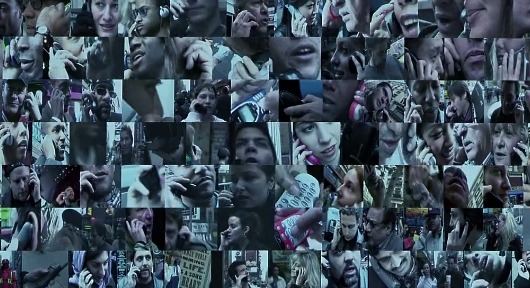
We asked our format expert, Matt, aka Formatman, to lead us through the 10 screenplay formatting commandments.
If you missed the introduction to this series of articles, you may want to check it out first.
Here is the link to Part 1, where it all started.
Whatascript:
Why dedicating a whole commandment to phoning?
Formatman:
Simply, because everyone uses a phone, and the screenplays - whether new or old - reflect that.
They are full of characters receiving or giving phone calls or talking about it.
And of course, the most famous line on that subject is:
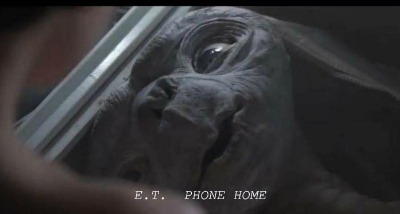
The screenplay format of a phone conversation is therefore very important.
Whatascript:
Why does the commandmant mention "one phone call" only?
Formatman:
Well, in terms of screenplay format, like in some places in life ...
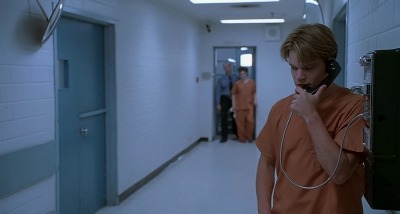
you get only one chance with the reader. You'd better not spoil it.
Whatascript:
What are the most common phone situations?
Formatman:
There are 3:
Whatascript:
What are the characteristics of this situation?
Formatman:
You use this situation when:
The dialogue from the character we see should be clear enough so that we get a sense of what the two people talk about or we get intrigued by what we don't know.
In terms of screenplay format, the most common ways to show that the character we see is listening and the other person we don't see, is speaking, is to use:
In line with the screenplay formatting commandment # 3 "Thou shalt not slow down the reader", be consistent and use the same format (ellipsis or wrily). Do not mix and match.
Whatascript:
Any example?
Formatman:
I'll give you three.
The first one is from Annie Hall, screenplay written by Woody Allen and Marshall Brickman.
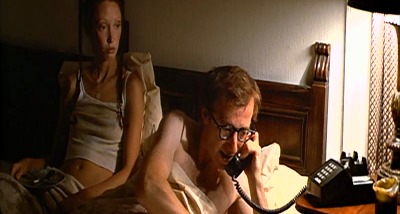
The telephone rings. Alvy picks it up, rising up slighltly from the bed, concerned, as he talks. ALVY Hello. Oh, hi ... Uh, no, what-what's the matter? What-what-what? You sound terrible ... No, what- Sure I- Whatta yuh -what kind of an emergency? ... No, well, stay there. Stay there, I'll come over right now. I'll come over right now. Just stay there, I'll come right over. He hangs us.
The next two examples are from Basic Instinct, screenplay written by Joe Eszterhas.
INT. HIS APARTMENT - NIGHT He is asleep on the couch -- the TV is on to a blank screen. The Jack Daniel's is mostly gone. The phone on the coffee table RINGS. It RINGS again. He wakes, picks it up, listens. NICK Yeah. (a beat) Okay. He hangs it up. He sits there a long beat, staring. He looks disturbed.
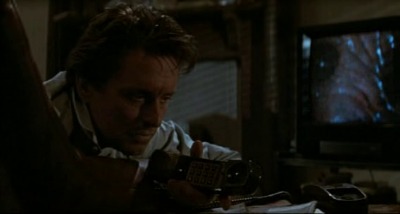
And a typical example of this phone situation when the person on the phone just provides information that the main character will then pass on to the audience
The phone RINGS. Andrews picks it up, listens. ANDREWS Thanks. He hangs up. ANDREWS Ballistics says the .38 we found in her apartment matches Nilsen. No registration. They're checking with Salinas. The icepick is the same brand and model as the Boz weapon.
In above cases, the screenwriters did not use the wrily (into phone) after each character to indicate they were speaking on the phone. They found it obvious.
In some other cases, when it's not obvious, you really need to use this screenplay formatting convention.
This is an example from Erin Brockovich, written by Susannah Grant:
INT. MASRY and VITITOE'S NEW OFFICE - DAY The front doors open and Erin enters. ERIN Hey, Ros. Nice view, huh? ROSALIND Yeah, I'm gonna start sleeping here. (into phone) Masry and Vititoe, can I -- damn it. (calling out) Does anyone know anything about these phones?
Whatascript:
When do you use this second situation?
Formatman:
Basically in 3 cases:
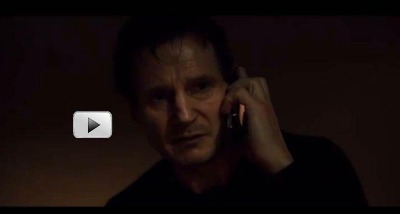
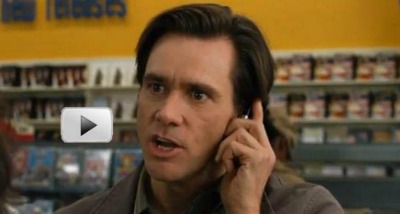
Whatascript:
In terms of screenplay format, how do you write these situations?
Formatman:
Like any dialogue with one difference. You use VOICE OVER (V.O.) for the character we do not see.
Coming back to the movie script Taken, the screenplay format of the dialogue would be as follows:
BRYAN I don't know who you are. I don't know what you want. If you are looking for ransom, I can tell you I don't have money. But what I do have are a very particular set of skills; skills I have acquired over a very long career. Skills that make me a nightmare for people like you. If you let my daughter go now, that'll be the end of it. I will not look for you, I will not pursue you. But if you don't, I will look for you, I will find you, and I will kill you. MARKO (V.O.) (after a long pause) Good luck. Whatascript:
In terms of screenplay format how do you write the situation when you don't want to reveal who's on the other end of the phone?
Formatman:
You can do like in Chinatown, screenplay written by Robert Towne, and use "VOICE ON PHONE".
In such a case, you do not need to use the (V.O.) screenplay format convention as it is obvious that it is a VOICE OVER.
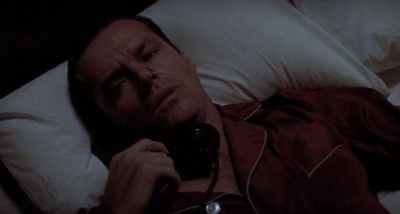
INT. GITTES' BEDROOM - GITTES Pads around in elegant silk pajamas. He walks over to the window where morning light is streaming in. He closes the curtains, collapses on the bed, on top of the covers, inert. Almost immediately the PHONE RINGS. Gittes lets it go for a moment, then picks it up without saying anything. VOICE ON PHONE (male) Gittes?... Gittes? GITTES Yeah. VOICE ON PHONE Ida Sessions wants to see you.
Formatman:
There are basically 2 screenplay formats which are the most used:
Whatascript:
How's the screenplay format in the first situation?
Formatman:
You start by a master scene heading. The character we don't see and who's on the phone, is followed by (V.O.). Then you switch to the next scene. And repeat the same process.
This is an example from Thelma & Louise written by Callie Khouri
INT. JIMMY'S APARTMENT - DAY JIMMY, mid-30's, musician, is standing in the kitchen on the phone. He's not the type you'd expect Louise to like, not quite straight-looking enough. LOUISE (V.O.) (on phone) Jimmy... INT. MOTEL ROOM - DAY Louise is looking at herself on the phone in the mirror. She is very choked up. JIMMY (V.O.) Louise! Where are you? Are you alright? Honey... LOUISE Hi. I'm okay. How are you? Long time no see.
Whatascript:
What are the pros and cons of this screenplay format?
Formatman:
The advantage is that you get to say who we see on screen.
This is in line with the Formatting Commandment #5 "Thou shalt direct without using camera directions".
The disadvantage is that you use additional lines every time you change scene and it may be in the way of an easy reading, which is against the Formatting Commandment #3 "Thou shalt not slow down the reader".
Whatascript:
What about the second situation, intercutting. What is it? and how does it work in terms of screenplay format?
Formatman:
Intercutting basically means that you first establish where each characters is, and then allow the director to go from one character to another whenever he wants.
You use in this case the screenplay format convention: INTERCUT.
It could be:
This is an example from Enemy of the State, screenplay written by David Marconi
INT. DEAN'S HOUSE/STUDY - NIGHT STACY is at the desk looking at the latest edition of the paper, which now has a photograph of DEAN and RACHEL walking in the park from the day before. The phone rings and STACY reaches for it... STACY (into phone) Hello?
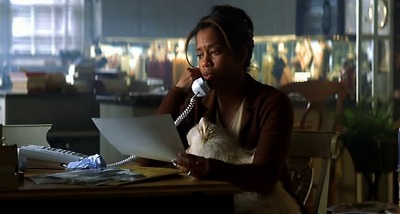
INTERCUT WITH: INT. HOTEL LOBBY - CONTINUOUS DEAN stands at a pay phone-- 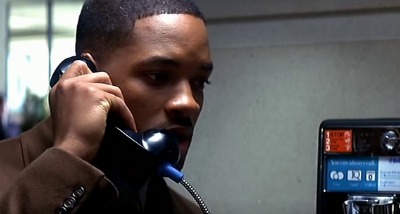
DEAN (into phone) Stacy, don't hang up. STACY Do you know what I'm looking at Robert? DEAN Stacy-- STACY I'm looking at a picture of you and Rachel taken yesterday. DEAN I know, but listen--
And this is an example from "The Bourne Ultimatum", screenplay written by Tony Gilroy and Scott Z. Burns and George Nolfi:
INT. BEHIND THRESHERS / WATERLOO CONCOURSE-- DAY INTERCUTTING BETWEEN ROSS AND BOURNE: Bourne spots the agents pulling back per Wills' orders. ROSS (INTO PHONE) If I run now I can make it-- 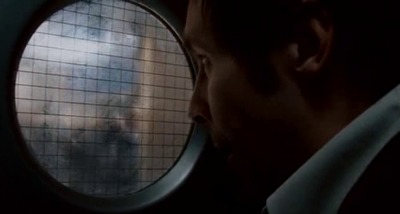
BOURNE (INTO PHONE) No. Something's not right.
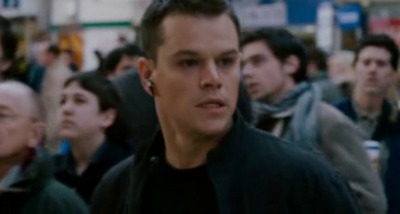
Whatascript:
What about an answering machine?
How do you deal with it in terms of screenplay format?
Formatman:
With a VOICE OVER.
This is an example from Thelma & Louise again:
INT. MOTEL ROOM - DAY ANSWERING MACHINE (V.O.) Hi. This is Jimmy. I'm not here right now... A VOICE interrupts the message: JIMMY (V.O.) Hello! I'm here. Hang on a minute! The machine switches OFF.
Whatascript:
Last question. What is the most unusual phone call you saw in all the screenplays you read?
Formatman:
It may not qualify as the most unusual, but this call is for sure out of the ordinary.
It comes from Dead Poets Society, screenplay written by Tom Schulman
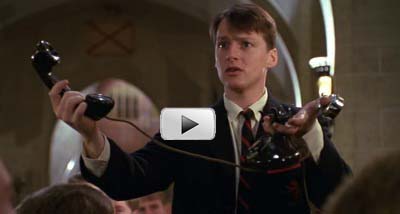
Whatascript:
This concludes our series of interviews on these ten screenplay formatting commandments.
Thank you, Formatman.
Formatman:
May the Format be with you!


You may not realize it but by taking this simple action you
empower us to write more articles like that - one Comment/Like/Share at a time.
Thanks for that.
Pictures and screenplay extracts:
-- "Phone Booth", Joel Schumacher (director), Matthew Libatique (director of photography)
-- "E.T. the Extra-Terrestrial", Steven Spielberg (director), Melissa Mathison (screenplay), Allen Daviau (director of photography)
-- "Good Will Hunting" - Matt Damon; Gus van Sant (director), Jean Yves Escoffier (director of Photography)
-- "Annie Hall" - Woody Allen, Shelley Duvall; Woody Allen (director), Gordon Willis (director of Photography), Woody Allen and Marshall Brickman (screenplay)
-- "Basic Instinct" - Michael Douglas (Nick); Joe Eszterhas (screenplay), Paul Verhoeven (director), Jan de Bont (director of Photography)
-- "Erin Brockovich" - Susannah Grant (screenplay), Steven Soderbergh (director), Edward Lachman (director of Photography)
-- "Taken", Liam Neeson; Luc Besson & Robert Mark Kamen (screenplay), Pierre Morel (director), Michel Abramowicz (director of Photography)
-- "Yes Man", Jim Carrey; Nicholas Stoller (screenplay), Peyton Reed (director), Robert Yeoman (director of Photography)
-- "Chinatown", Jack Nicholson; Robert Towne (screenplay), Roman Polanski (director), John A. Alonzo (director of Photography)
-- "Thelma & Louise", Callie Khouri (screenplay)
-- "Enemy of the State", Will Smith, Regina King; David Marconi (screenplay), Tony Scott (director), Daniel Mindel (director of Photography)
-- "Bourne Ultimatum", Matt Damon, Paddy Considine; Tony Gilroy and Scott Z. Burns and George Nolfi (screenplay), Paul Greengrass (director), Oliver Wood (director of Photography)
-- "Dead Poets Society", Gale Hansen; Tom Schulman (screenplay), Peter Weir (director), John Seale (director of Photography) -- "Thelma & Louise" - Callie Khouri (screenplay), Ridley Scott (director), Adrian Biddle (director of Photography)
Go from Screenplay Format to Whatascript! Home page
* Inception, screenplay written by Christopher Nolan